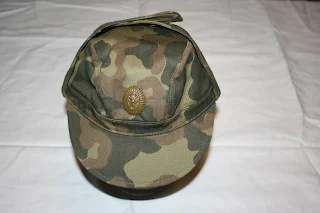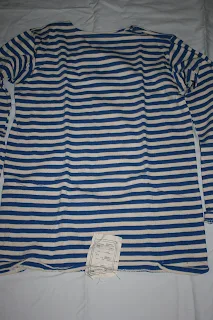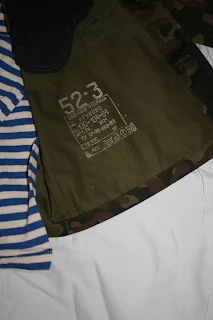With the downfall of the Soviet Union in August of 1991, subsequently there was a short time window when all manner of Soviet Military Forces then current, genuine uniforms and equipment became available to the West. Simultaneously the author was retiring from naval intelligence with the U.S. Naval Reserve after 29 years.
Having acquired a reasonable knowledge of the armed forces of the Soviet Union over that span of time, I decided to acquire a mini collection representative of our “former adversary”, for posterity. In addition, to the best of this author’s knowledge, as of this point in time there has not been any significant replication, i.e. fake uniform/insignia/equipment production, with the single exception of fake caps.
The following is an excerpt from a website article from a major store specializing in Soviet uniforms and equipment:
“When I first started this site in 2003, I indicated fakes were not a major concern for Soviet uniform/cap collectors. This was true at the time, since there was a major "glut" of authentic caps entering the market. But since then, a major fake/replica industry has developed. When fakes first showed up - they were usually high-end types, general and admiral caps made with authentic materials left over from the collapse of the USSR, which were rarely encountered by the casual collector. The next wave of reproductions were just that - reproductions intended primarily for the military re-enactors, especially for WWII. Now, however, a large percentage of Soviet caps offered for sale on auction sites and on Soviet militaria websites are fake. Many of these modern fakes are coming out of Ukraine although others now originate from Pakistan. Interestingly enough, the quality of most current replica general and admiral caps has deteriorated (with silk embroidery vice metal wire embroidery), while fake Soviet officer and soldier caps are often very well made with materials very close to the originals. So be VERY CAREFUL when buying a cap that looks new. Ask me if you have any doubts before buying something you're unsure of. I am always happy to help. In the following paragraphs I have attempted to discuss these different categories of "fake" caps, why they exist and what to look for in "suspect" caps.”
The serious collector of Soviet vintage militaria is well advised to visit the following: http://www.undertheredstar.com/fakes.htm
So obviously this article is intended to provide the reader with a set of imagery which can be used to compare with any suspected items. Of specific interest should be the labels and/or stamps that are found on the uniforms, hats, and equipment. The other element of authenticity to be observed are the various sets of flaps/tabs, and the integral concealed holster for a Makarov in the jacket. This occurrence was precisely why this author acquired all of his Soviet collection very early on in the 1991-1992 time frame.
I chose a field service uniform of a Colonel of the Russian Airborne Forces or VDV (from "Vozdushno-desantnyevoyska Rossii", Russian: Воздушно-десантные войска России, ВДВ; Air-landing Forces). Basically the uniform consists of the M1984 “Flora” pattern camouflaged jacket and trousers, in addition to the classic light blue and white striped telniashka and turquoise blue beret. Officers and NCO’s most commonly wore a brown leather Sam Brown type belt, with a matching brown leather holster (w/spare magazine pocket) configured for the 9x18mm Makarov PM pistol, or the wood or plastic combination stock/holster for the 9x18mm Stechkin APS machine pistol.
Having reviewed a reasonably extensive reference library, it can stated that other than the subdued insignia which will be seen on the included imagery, no other distinguishing insignia is wore on this specific uniform, not even their parachutist jump qualification badge. Having been said, there is always at least one known exception; being the late VDV Lieut General Alexander Lebed during the turbulent early 90s, with the demise of the Soviet Union. He is seen (with attribution and gratitude to alamy), taking an oath of allegiance wearing lieut general officer's service shoulder boards. Note the other officers in the photo are not. It is the identical uniform, with exception of lower rank, which I will be describing.
There are other post-Soviet era images showing a similar uniform with an extensive array of insignia, but the uniform’s camouflage pattern is decidedly different than the Soviet “Flora” pattern. An example is the following image of the late Lieut Colonel Anatoly Lebed, Hero of the Russian Federation, who was a Spetsnaz officer. Note his
There is a range of headgear, in addition to the classic blue beret, which were wore by all ranks of the VDV and Spetsnaz. Surprising a camouflaged “deer-slayer” type utility hat, with a subdued cap badge was worn quite frequently. It will be shown in the imagery. In addition the khaki cloth padded jump helmet and the winter service, blue-grey, wool and synthetic fur ushanka, will also be depicted.
Here are additional images of the classic VDV/Spetsnaz turquoise blue beret, showing both details of the beret and its labeling.
As previously discussed, one of the other very common caps worn during the waining days of the Soviet Union was what the author choses to call a "deer-slayer" utility type cap, in a camouflaged "Flora" pattern.
The next significant uniform item is the classical turquoise blue and white striped, long sleeved wool jersey called the telniashka.
Next is the summer weight "Flora" camouflaged M1984 jacket with subdued insignia and the integral concealed holster for the Makarov pistol.
The camouflaged trousers have one feature to be mentioned, that being a pair of straps which can be fastened under each foot to hold the pant legs in the boot.
Believe these to be enlisted, not officer's (which are taller by 2" and smooth black leather), field service boots of pebble-grained black leather, however commonly worn by all ranks. Their surface is very similar to the classic WWII British Army ammunition boot.
The final element of the normal field service uniform is the brown leather holster and Sam Brown type belt.
The specific 9x18mm Makarov pistol depicted is somewhat unique, and is discussed in detail in a previous article in this blog: https://arnhemjim.blogspot.com/2018/02/an-interesting-makarov-pistol-open-to.html.
As was previously discussed, there was no additional insignia wore with the uniform, however the next image displayed shows an array of insignia normally wore on either service or parade dress by both VDV and the Spetsnaz units.
The Captain's dress shoulder boards, collar tabs and VDV branch of arms, along with the Guards designated award, various grades of parachute jump proficiency and master grade proficiency are more readily recognized. The large patch with the wolves head, parachute canopy and wings is the 218th VDV Spetsnaz Battalion. The Soviet Naval Infantry (also wore by Naval Spetsnaz), is followed on the lower right by the KGB Interior Troops branch of arms. The remaining two badges are the Voyage pin of the Aircraft Carrier Kuznetzov (1993) and the pilot's wings of The Soviet Air Force (VVS), sniper pilot grade (1990).
The remaining two items are the standard jump helmet of the VDV, somewhat of a hybrid of a Soviet tanker's helmet and a British WWII sorbo training helmet for parachutists, and finally the VDV officer's winter ushanka.































1 comment:
Great!
Post a Comment